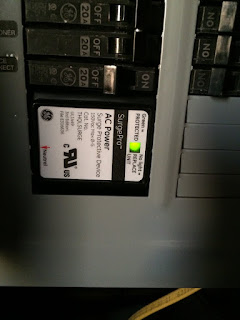Just recently I have had HVAC/AC issues where a lightning
storm caused my circuit board to stop working.
Fortunately, I had a warranty on all parts for my unit! Unfortunately,
Samsung does not allow the home owner to work on their own unit and a
"Licence Professional" has to call in to order the parts. Well this
just makes me upset that I am not able to fix it myself and I have to pay
someone to do the exact thing that I could do!
Alright alright I'll get off my soapbox now and get back to
the topic at hand. Installing an AC surge protector. Most people are familiar
with the simple surge protector that is used on electronics inside of your
home. However, not many people realize that your AC unit has just as many
electrical components in it as your computer or TV (including myself until
recently). Unfortunately, the AC surge protectors are not as simple to install
as unplugging your electronic and plugging into your electrical strip. But
anyone with a little guidance can install one of these AC surge units without
having to pay for expensive electricians.
** Note: I am not a license professional electrician. I am a
normal guy who understands basic electrical issues and has learned the hard way
that if you don't know what you are doing with electricity either ask or pay someone
who does. Please proceed with at your own risk! **
Step 1: Knowing your Electrical Panel
The first step in installing your AC surge protector is
knowing what to buy. This can be easily solved by going and looking at your
electrical breaker box. Different breaker box brands have different parts and
for the most part they are not inner changeable. I happened to be working in my
garage which has a sub panel in it. My sub panel is a GE breaker box. Other
common breaker boxes would be Square D, Eaton, or Cutler Hammer.
Once I knew what brand I had I went to the local big box
store (Home Depot) and purchased a GE AC SurgePro. The surge protector I ended
up buying is designed not only to protect the AC unit but also the whole
breaker panel. Which in my mine the more protected the less I will have to fix
the next electrical storm we get!
Step 2: Installing
A little background on me; I hate reading instructions! I am
that guy that refuses to read the instructions because I want to figure it
out. Except with electrical stuff. I will read electrical instructions. Even
though this is a simple install I still suggest you read the instructions!
Different surge protectors will have different locations for
mounting. This type of protector is actually mounted directly into the breaker
box next to the AC breaker. The other types could be mounted either next to the
disconnect on the outside unit or even as an attachment to your breaker box.
I started this install by killing the main breaker to my
box. Safety first!
I then removed the panel's face to expose the breakers and
bus bars. Double checking that there isn't any power going to the unit I used a
Voltage Tester as well as an Ohms meter.
The install then was just snapping the SurgePro into an
empty slot in the box and connecting the white neutral wire to the neutral bus.
Before I put the panel face back on the box I turned the
power back on and checked to make sure the green light on the surge protector
came on. This light lets you know if the power surged and the unit activated.
These protectors are a one time use device so if the light is not lit up it is
time to replace the unit.
 |
| Final Product! |







There are whole house surge protects that you install that aren't one time use. My neighbor blew out his system with a surge that came from the ac unit, and we installed one in our house the next week. They aren't hard to do yourself, but you do need to take those basic precautions like turning off the main breaker.
ReplyDeleteTommy, Thank you for the comment!
DeleteYes, there are different surge protectors out there that are better than the one that was installed here. At the time this was the best option I had to choose from.
If/when this protector becomes inoperable I plan on updating this post with a better protector!
Thanks again for reading!
A very helpful blog on surge protection device, I am having this device at my home and also at my office. It is efficiently running since 3 years. No problems as previous was.
ReplyDelete